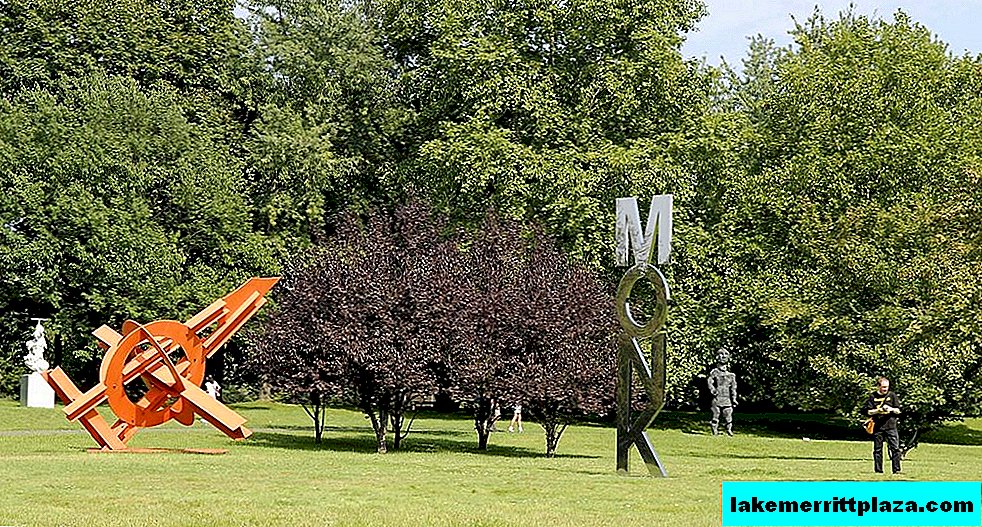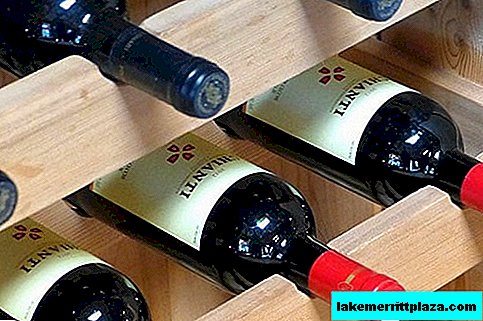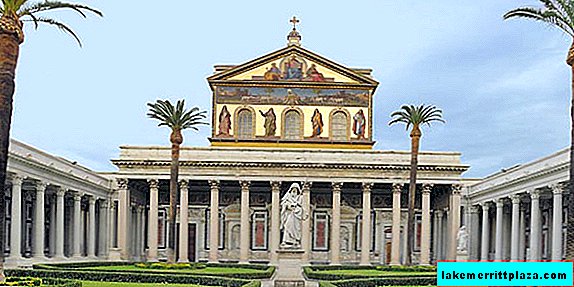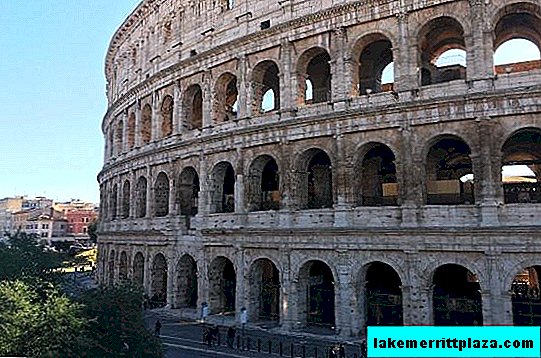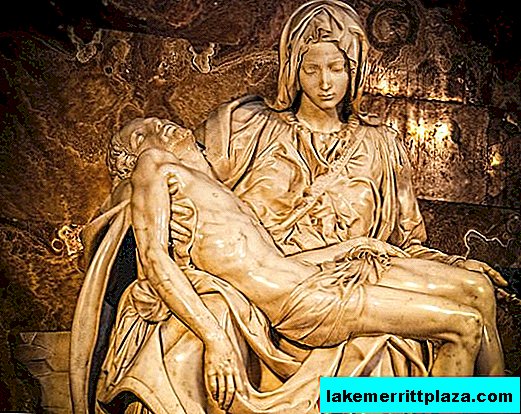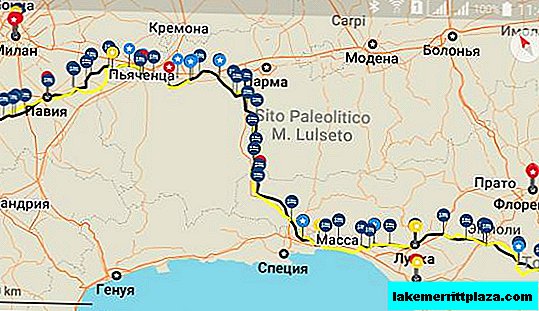The Royal Palace in Caserta is called one of the main attractions near Naples, and many travelers, constrained in time, prefer to pay attention to him, even to the detriment of Pompeii, Vesuvius or the Amalfi Coast. What is remarkable about the Palace when it works and how to visit it from Naples - you will learn about this and much more from this article.
... 35 km from Naples is the largest palace, erected in Europe in the XVIII century. In 1997, this Baroque architectural masterpiece was inscribed on the UNESCO World Heritage List.
Why you should visit the Royal Palace in Caserta
In the Royal Palace in Caserta, abundance and luxury know no bounds. Everything here was supposed to remind of the best parks and palace complexes in Europe, primarily Versailles. It is hard to believe that many of the architect's ideas have remained unfulfilled.
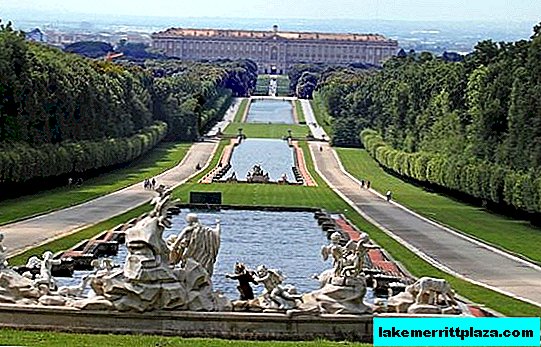
A park with a long avenue of fountains closes the cascade of waterfalls
It is not surprising that these days the monumental construction often attracts filmmakers: some episodes of Star Wars, the films Mission Impossible 3, Da Vinci Code and Angels and Demons were shot in the interiors of the palace in Caserta.
No less interesting is the park spread out behind the palace with a long avenue of fountains, which is closed by a cascade of waterfalls. The total length of the park zone is over 3 km.
History of the Royal Palace in Caserta
The construction of a new royal residence in the middle of the XVIII century was conceived by Charles VII of Naples. To implement his plan, he invited the architect Luigi Vanvitelli.
The construction of the palace, designed to show the world all the power and grandeur of the Bourbon house, began in 1752.
True, the initiator of the project was never able to feel himself in the role of master: in 1759, Charles VII became king of Spain, and only his third son, Ferdinand IV, took over the palace.
To build the palace, local residents had to be relocated 10 km to the side, and the silk factory was disguised as a park pavilion. It was also planned to pave the way straight to Naples, but this project was never completed.
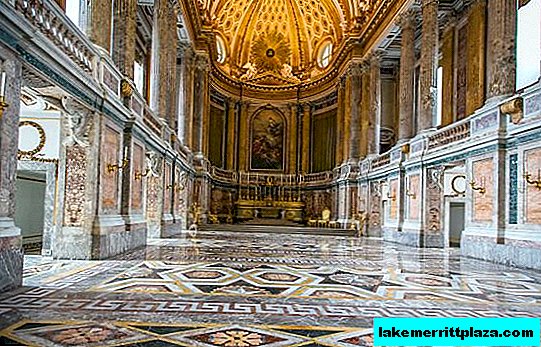
In the Royal Palace, abundance and luxury know no bounds
The grandiose construction was completed only in 1780, however, he pleased the dynasty of customers for a relatively short time.
Already in 1806, Napoleon settled here his brother Joseph Bonaparte, and the Bourbon family was forced to flee to Sicily. In 1808, Joseph was appointed king of Spain, and his place in Naples was taken by Joachim Murat, who spared no expense in transforming his new residence.
After the defeat of Napoleon, the power of the Bourbons was restored, but this time the palace served the royal residence only for several decades.
The unification of Italy saved the palace from its main function, gradually it fell into desolation, and in 1919 it was transferred to the ownership of the state.
What to see and what to look for
The scale of the Royal Palace in Caserta is truly impressive. On an area of 47 thousand square meters, 1,200 rooms, 20 state departments, as well as the Royal Theater are located (for comparison, 1,084 rooms in the Hermitage).
Only some halls are open for visiting, but this is enough to linger in the palace for several hours.
It is worth saying that the palace in Caserta has a curious, albeit strict form: it is like a frame with a cross inscribed in it, so that the inside of the palace forms four courtyards. They can be seen simultaneously from the center of the octagonal lower lobby in the middle of the gallery.
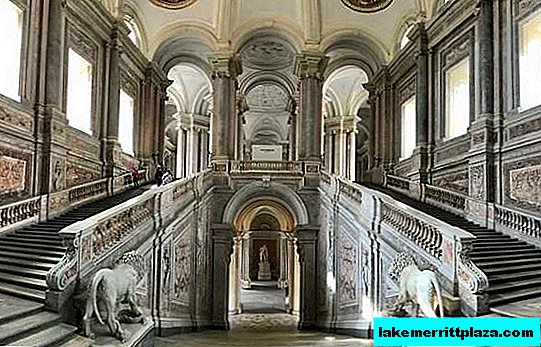
The famous "Ladder of Glory" - one of the most luxurious in Europe
The interiors of the palace are generously decorated with sculptures, painted ceilings and medallions with allegories.
Each guidebook mentions the “Ladder of Glory”, along which visitors climb to the halls of 2 floors. The upper spans of this staircase are made of solid pieces of marble.
Among the most luxurious halls are the halberdier’s hall, the personal guard hall, the Alexander’s salon, exalting the Macedonian conqueror, the halls of Mars and Astrea, and, of course, the Throne Hall.
Special mention deserves the Presepe Reale Hall. A sculptural Christmas composition is stored here, which is called Lo scoglio and consists of 1200 figures located on an area of 40 sq m in accordance with strict rules.
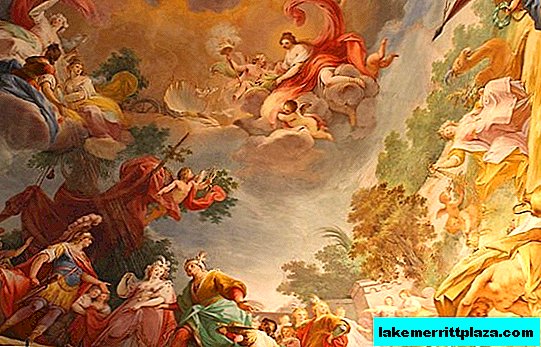
The ceiling fresco "Kingdom of Apollo" by Girolamo Starace-Francis
The Christmas scene of the worship of the Magi is complemented by the everyday scenes of "The Market", "At the Fountain" and "Neapolitan Tavern" with figures of musicians.
There is also its own Palatine Chapel in the palace, where the painting "Immaculate Conception" by Giuseppe Bonito is installed on the main altar. After the bombing in 1943, of the eight paintings stored here, only she survived.
It is worth mentioning about the court theater, which looks like two drops of water on the Neapolitan theater "San Carlo". An unusual element of scenography was separately invented for him: a portal with access to the park, and the king could get into his box through a separate entrance.

The park area of the palace is decorated with numerous fountains and statues.
That the natural landscapes corresponded to the luxury of the interior of the palace, the creators of the complex took care separately. The park area was decorated with numerous fountains, busts and statues.
The park, broken up behind the palace, can be conditionally divided into three zones: the park itself with flowers and trees, a long walking alley with fountains and a cascade of waterfalls descending from the hill.
The gorgeous view of the palazzo and its surroundings from the highest point of the complex can be a great end to exploring the Royal Palace in Caserta.
How to get from Naples to the Royal Palace in Caserta
A direct train follows from Naples to Caserta. He leaves from the Napoli Centrale station and arrives at the Caserta station, from where the palace is within easy reach. Travel time is 40-50 minutes. The fare is 3.14 euros (2019).
You can also go to Caserta directly from Naples Airport by bus. The road takes only 35 minutes. The trip will cost about 4 euros.
Palace opening hours
From April to September, the palace is open from 08:30 to 19:30, in January-February and in November-December - from 08:30 to 15:30. In March and October, respectively, from 08:30 to 17: 00/17: 30.
The park, as a rule, closes half an hour earlier. Entrance to the English Garden is limited and is strictly scheduled, about once every hour and a half.
Tuesday is a day off. The museum is also closed on January 1, May 1, December 25 and on Easter Monday.
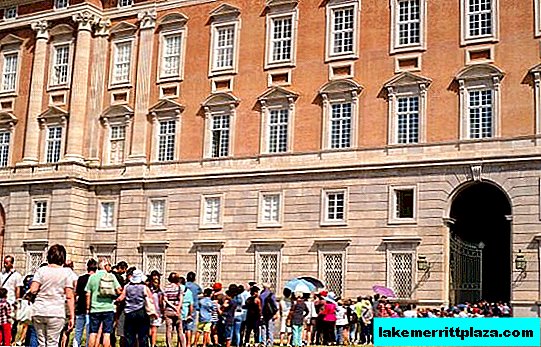
A single ticket to the palace and the park costs 12 euros
Caserta Royal Palace Tickets
In place of a single ticket to the palace and the park costs 12 euros (preferential - 6 euros). You can only get to the palace for 9 euros (preferential - 4.5 euros), only to the park - for 8 euros (preferential - 4 euros).
To avoid entry queues, tickets can be purchased in advance via the Internet. You can do this on the Getyourguide website. In this case, the tickets will be several euros more expensive, but you will save a lot of time and nerves at the box office.
As for the benefits, they apply to young people aged 18 to 24 years. Visitors under the age of 18, as well as students of art universities are entitled to free admission to the museum.
An audio guide is available in Italian, English, French, German and Spanish. The cost is 5 euros. There is no audio guide in Russian.
If you get tired of walking, you can travel around the park on a small shuttle bus (2.5 euros) or ride a bike (4 euros per hour).
Other Useful Articles About Naples
- What to see in Naples on your own in 1 day
- 5 most interesting excursions in Naples
- Naples airport and how to get to the city
- How to get from Rome to Naples
Photos by: Justin Ennis, getyourguide, Anna & Michal.

